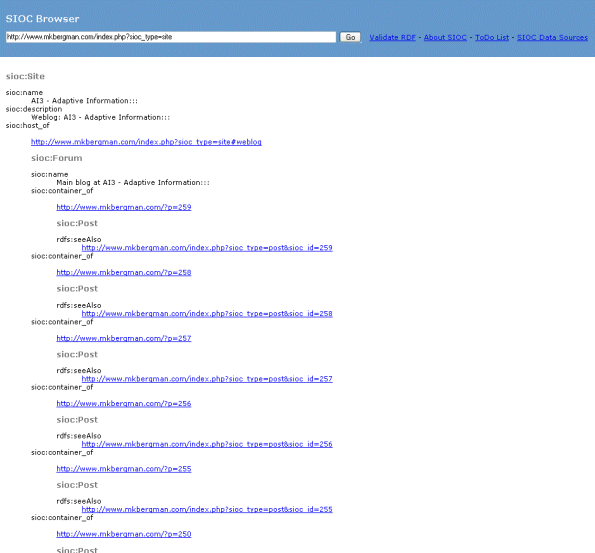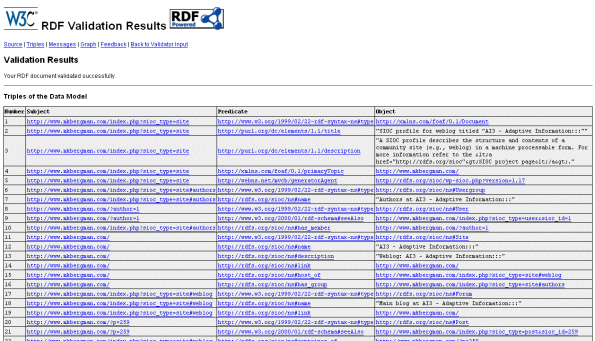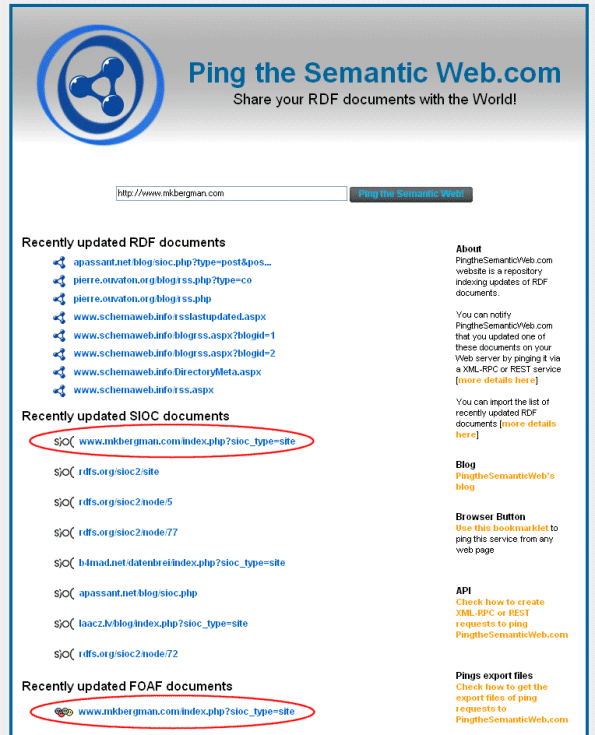Author’s Note: There is zipped HTML and Javascript code that supports the information in this post. If you develop improvements, please email Mike and let him know of your efforts.
 Click here to download the zipped file (2 KB)
Click here to download the zipped file (2 KB)
Due to a recommendation by BrightPlanet’s lead programmer, Will Bushee, I was also turned to another online translation service from Applied Language (AL). In addition to the nine languages handled by Google in its English translations covered in my previous post, AL adds Russian and Dutch. And, so, again with Graham Beynon’s able Javscript assistance, my online translation system has now been expanded to 11 languages — Arabic, Chinese (simplified and traditional), Dutch, French, German, Italian, Japanese, Korean, Portuguese, Russian and Spanish — in two services. Thanks again, guys!
This now allows you, the user, to directly compare translation quality, which both services acknowledge as being less than perfect. It will also enable me over time to see which of the services and for which languages readers of my site prefer.
An Example Comparison
My earlier post drew some criticism of machine translation from Graham Higgins, using the example of his sister-in-law’s German Web site translated to English. To test some of these changes myself, I decided to roundtrip both the Google and Applied Language services for my site, arbitrarily picking Portuguese for the example. I began with some text from my online bio, using simple cut-and-pastes with no HTML formatting on a base of about 150 words:
Michael K. Bergman is a co-founder, chief technology officer, and chairman of BrightPlanet Corporation, and a Web scientist.
Mr. Bergman began his professional career in the mid-1970s as a project director for the U.S. EPA for a major energy study called the Coal Technology Assessment (CTA). He later taught in the Graduate School of Engineering at the University of Virginia and was a fellow in the Energy Policies Study Center. Mr. Bergman joined the American Public Power Association in 1982 and was soon promoted to director of energy research. He quadrupled the trade association’s voluntarily supported R&D program to 500 members.
He remained at APPA for seven years then formed his own successful technology commercialization company, Instar Community Systems, Inc. At Instar, Mr. Bergman helped create three technology commercialization groups in fuel cells, photovoltaics and biomass energy. In late 1994 he founded VisualMetrics, the developer of the technology now owned by BrightPlanet.
Here is Google’s translation to Portuguese based on its online service:
Michael K. Bergman é um co-founder, um oficial principal da tecnologia, e um presidente de BrightPlanet Corporaçõ, e um cientista da correia fotorreceptora. O Sr. Bergman começou sua carreira profissional nos mid-1970s como um diretor do projeto para os ESTADOS UNIDOS EPA para um estudo principal da energia chamado a avaliação da tecnologia de carvão (CTA). Mais tarde ensinou na escola graduada de projetar na universidade de Virgínia e foi um companheiro no centro do estudo das políticas de energia. O Sr. Bergman juntou a associação pública americana do poder em 1982 e foi promovido logo ao diretor da pesquisa de energia. Quadrupled o programa voluntàriamente suportado do R&D de associação comercial a 500 membros. Remanesceu em APPA por sete anos a seguir deu forma a sua própria companhia bem sucedida do commercialization da tecnologia, sistemas da comunidade de Instar, Inc. Em Instar, em Sr. Bergman ajudado criar três grupos do commercialization da tecnologia em células combustíveis, em photovoltaics e em energia do biomass. Em 1994 atrasado fundou VisualMetrics, o colaborador da tecnologia possuída agora por BrightPlanet.
Here is Applied Language’s translation to Portuguese based on its online service :
Michael K. Bergman é um co-founder, um oficial principal da tecnologia, e um presidente de BrightPlanet Corporaçõ, e um cientista da correia fotorreceptora.
O Sr. Bergman começou sua carreira profissional nos mid-1970s como um diretor do projeto para os ESTADOS UNIDOS EPA para um estudo principal da energia chamado a avaliação da tecnologia de carvão (CTA). Mais tarde ensinou na escola graduada de projetar na universidade de Virgínia e foi um companheiro no centro do estudo das políticas de energia. O Sr. Bergman juntou a associação pública americana do poder em 1982 e foi promovido logo ao diretor da pesquisa de energia. Quadrupled o R voluntàriamente suportado de associação comercial . . .
Here is the Google Portuguese translation roundtripped back to English:
Michael K. Bergman is to co-founder, a main officer of the technology, and a president of BrightPlanet Corporaçõ, and a scientist of the fotorreceptora leather strap. Mr. Bergman started its professional career in mid-1970s as a director of the project for United States EPA for a main study of the energy called the evaluation the coal technology (CTA). Later he taught in the graduated school to project in the university of Virginia and was an friend in the center of the study of the energy politics. Mr. Bergman joined the American public association of the power in 1982 and was soon promoted the director of the energy research. Quadrupled the program voluntàriamente supported of the R&D of trade association the 500 members. It remained in APPA per seven years to follow gave to form its proper successful company of commercialization of the technology, systems of the community To urge, Incorporation In Urging, Mr. helped Bergman to create three groups of commercialization of the technology in combustible cells, photovoltaics and energy of biomass. In 1994 been slow it established VisualMetrics, the collaborator of the possessed technology now for BrightPlanet.
Here is the Applied Language Portuguese translation roundripped back to English:
Michael K. Bergman is to co-founder, a main officer of the technology, and a president of BrightPlanet Corporaçõ, and a scientist of the fotorreceptora leather strap.
Mr. Bergman started its professional career in mid-1970s as a director of the project for United States EPA for a main study of the energy called the evaluation the coal technology (CTA). Later he taught in the graduated school to project in the university of Virginia and was an friend in the center of the study of the energy politics. Mr. Bergman joined the American public association of the power in 1982 and was soon promoted the director of the energy research. Quadrupled the R voluntàriamente supported of trade association . . .
Observations
It is clear that neither machine translation is perfect and that AL’s online service also truncates to a shorter result (both do OK viz length when used as an embedded site translator as my blog example indicates). Technical terms (I love the fotorreceptora leather strap roundtripped translation for Web!) and capitalization, not to mention pronouns and possessives, appear to be especially problematic. But, nonetheless, for a non-native speaker, the translations do generally convey the subject matter and thrust of the original document. While no one would argue that these machine translations could be depended upon for actionable intelligence — likely qualified human translators are necessary for that — machine translation can get us close to the ballpark.
Of course, each iteration in a machine translation cascade introduces errors, and roundtripping as the examples above show have two levels of errors. For example, here is the still further degraded result after five roundtrips using the Google Portuguese service:
Michael K. Bergman is to co-founder, a main officer of the technology, and a president of BrightPlanet Corporaçõ, and a scientist of the brace of the leather of the fotorreceptora. Mr. Bergman started its professional career in mid-1970s where a director of the project for United States EPA for a main study of the energy called the evaluation the coal the technology (CTA). Later he taught in the graduated school to project itself in the university of Virginia and was a friend in the center of the study of the politics of the energy. Mr. Bergman joined the American public association of the power in 1982 and was soon promoted the director of the energy research. Voluntàriamente Quadrupled trade association supported of the program of the R&D the 500 members. It remained in APPA per seven years to follow gave to give to give to give to give to form its appropriate successful company of commercialization of the technology, of the systems of the community to agitate above of, of the incorporation in agitating, Mr. Bergman helped above creating three groups of commercialization of the technology in the stacks, photovoltaics and the fuel of the energy of biomass. In 1994 been slow it it established VisualMetrics, collaborator of the possessed technology now for BrightPlanet.
Compare that to the first roundtrip and you can see that further errors were introduced.
Naturally, even greater degradation occurs when passing through multiple languages, with this example of English-German-French-English:
Michael K. Bergman is a more technologieoffizier one Cogründer, and a president de BrightPlanet corporation and scientists of network. Mr Bergman began his professional career in the middle of the years 70-iger as a director of project of the United States EPA for an energy energy study which was called the estimate of coal technology (CTA). He informed later of the vehicles in the study of energy policy in the school obtained a diploma of the technique at the university of Virginia and was a medium. Mr Bergman connected American general energy to relation in 1982 and was encouraged soon with the director of energy research. He quadrupled voluntarily the supported relation AND RESEARCH program for 500 members. It remained, melted then with APPA its own company of marketing of successful technology, Instar for seven years of Community systems, helped Inc with of Instar, Mr Bergman to cause three groups of marketings of technologies in the fuel cells, photovoltaics and in the energy of mass of life. Late in 1994 it founded VisualMetrics, the promoter of the technology which was had now by BrightPlanet.
The key point, however, is that as a screening tool and as a means for non-native speakers to generally grasp subjects and topic areas, machine translation can be an impressive and productive aid.
Instructions for Updating Your Own Translations
To add the Applied Language translations and its added languages as my blog now sports, you will first need to sign up and get a unique key, plus list the languages desired. Please see here for the Applied Language sign up page. AL will then send you an email with the HTML and the unique ID for your domain. You NEED this key! Using the Javascript listed above, you can then replace with your unique key in the “value” field and then embed the system within your blog or Web site, similar to the instructions in my previous machine translation post. Good luck!





 Click here
Click here













